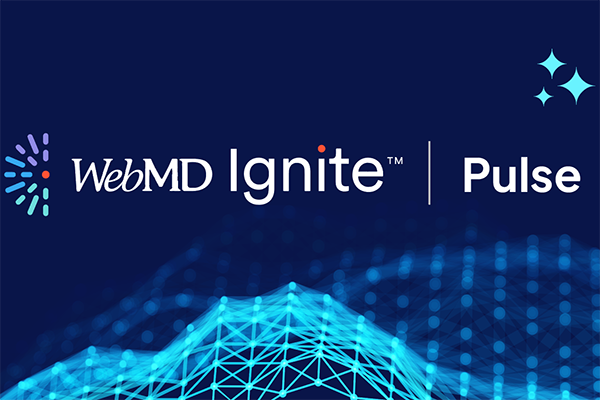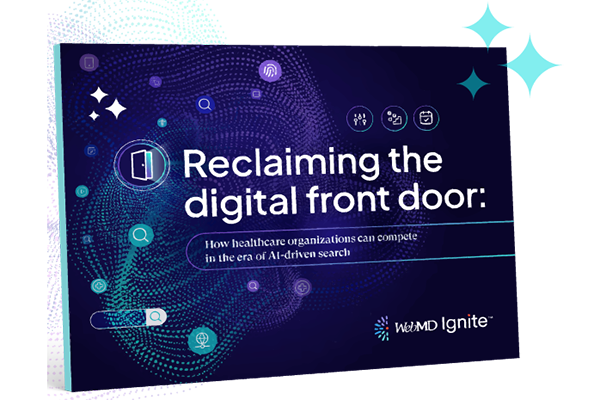Predictive Analytics in Healthcare: Key Benefits and Use Cases

Categories: health plans, health systems, healthcare organizations, associations
Editor's Note: This blog was published prior to the transition to WebMD Ignite.
Imagine a world where every health condition was recognized and treated before they even emerged.
Today, physicians across the country are doing everything in their power to keep patients in good health through prevention and early intervention. However, healthcare organizations can look to their data and analytics to better support patients before, during and after their visit. The key to success is predictive analytics.
Through the use of predictive analytics and predictive modeling, healthcare organizations can analyze massive amounts of patient, consumer, and market data, then output actionable insights about a patient’s future healthcare needs. This creates a win-win situation for patients and providers.
Let’s dive into what predictive analytics means for healthcare organizations and uncover how it can help you make better operational decisions, improve patient outcomes, and increase patient engagement.
What is predictive analytics and predictive modeling for healthcare?
Predictive analytics is a statistical technique that uses artificial intelligence (AI) and machine learning (ML) to make meaningful predictions based on patterns in both real-time and historical data.
Specifically, when used through the lens of predictive models, these techniques work by feeding a model with data acquired from many sources, including clinical, consumer, and healthcare activity data. The model then uses that data to make predictions about future behaviors. After some time, the algorithm is able to make accurate and actionable insights.
For example, you could train a model for chronic conditions by feeding it a dataset of patients with known outcomes. Then, you could feed the model data about real patients without a diagnosis or outcome to flag those that are at risk of a chronic condition.
Beyond improving patient care, predictive models can also help health systems determine which touchpoints consumers are likely to engage with, or predict future demand for a given service line. Overall, predictive analytics helps a multitude of healthcare stakeholders better understand whatever is going to happen next based on statistics and historic data.
3 benefits of using predictive analytics in healthcare
Predictive analytics is so powerful because it allows you to better anticipate needs and allows providers to identify important patterns and trends from data. This helps providers discover actionable insights to improve overall clinical outcomes, build actionable population health initiatives, and increase overall patient engagement and patient retention.
Support operational decision-making
Healthcare organizations can use predictive analytics to derive insights that help achieve organizational goals and improve operational decision-making. It can help to determine:
- Opportunities for organizational growth
- Where best to allocate your marketing budget
- Which segments provide the most patient lifetime value
- How to optimize resources to grow your market share
A compelling use case for predictive analytics is anticipating demand for services with supply/demand models. For example, imagine your team was planning to run a promotional campaign for your cardiac service line. Before you invested a single dollar in the campaign, you consulted a cardiac-specific supply/demand model. When you did so, you found that an effective cardiac health campaign would increase patient demand beyond your service line’s total capacity for care.
Once equipped with that information, it could spur a variety of operational decisions. Perhaps you could focus on a different service line – or you could increase the capacity of your cardiac service line. Overall, predictive analytics can help ensure you invest your resources where they matter most.
Focus on at-risk populations
Predictive analytics can help to predict patients' care needs and improve their outcomes. By using a mixture of patient, consumer, and market data, you can:
- Predict the likelihood that a specific treatment plan will be effective
- Track chronic conditions
- Identify warning signs before conditions become untreatable
- Determine whether a patient is at risk for developing certain infections or conditions
- Improve your approach to population health and health equity
With these clinical predictions, providers can identify those who have a high risk for chronic diseases, intervene early, and create proactive plans to drive engagement and promote health and wellness for those most in need.
Increase patient engagement
Predictive analytics isn’t only helpful in treating patients, but also in determining the best ways to reach and engage patients. Effective long-term engagement with patients is essential to reduce risks associated with chronic conditions and help them manage their own care as much as they can.
By using analytics to evaluate a patient’s previous behaviors and interactions with your practice, you can predict what type of outreach is most likely to deliver the desired result. This means you can prioritize patients who are most likely to change something in their lifestyle, reducing costs and increasing the effectiveness of your services.
You can also use analytics to determine how successful your patient targeting efforts are which helps you to measure and optimize your outreach, patient retention, and ROI. Further, you can pinpoint growth opportunities and develop a detailed understanding of the healthcare needs of your consumers and patients.
Use cases of predictive analytics in healthcare
Predictive analytics is useful at each step in a patient’s journey. It drives more personalized care, early interventions, optimized operations, and reduced costs. Here are some of the ways that healthcare organizations deploy predictive analytics to discover actionable insights from their data.
Identifying relevant audiences
Let’s say you wanted to expand your orthopedic service line — namely, knee replacement procedures. The right healthcare analytics tool makes this a fairly straightforward process. Simply connect your data to an orthopedic services predictive model, let the tool run its analysis, and in a few moments, you’ll have a relevant audience to target.
Then, the model contextualizes these audiences with behavioral clusters like “patients with osteoarthritis” or “patients affected by knee trauma”. These clusters explain the “who” and “why” of the target audience and help you to craft highly relevant messages with the perfect CTA to influence patient behavior.
Market & service line planning
Effective service line planning requires an in-depth understanding of competitors, the market, and internal clinical operations. With access to high-quality data, predictive analytics can provide valuable insights in this regard and provide best next actions for your marketing team to consider.
By analyzing key market and operational indicators through a predictive model, providers will be able to quickly identify the best opportunities and the best way to achieve a positive outcome. Healthcare organizations can then use this information to determine the optimal resource allocation to prioritize growth opportunities.
Uncovering consumer/patient persona insights
With predictive analytics, you can generate rich persona and segmentation profiles using models that access demographic, household, and clinical data. This will help your team uncover the messaging they need to improve engagement, acquisition, and retention. It can also help you maximize patient lifetime value and improve the overall patient experience.
In the end, this will help you improve patient acquisition and retention through marketing campaigns that are highly relevant to those who need your services.
Population health and health equity
Healthcare organizations can use analytics to better understand their patients, both individually and as a part of larger demographic groups.
For instance, predictive analytics can help to determine:
- Which patients are likely to no-show
- Which patients are likely to adhere to their treatment plan
- How to best reach certain patients or patient populations
From there, they can analyze data regarding patients’ existing conditions, treatments, and demographics to find patterns within similar population cohorts and inform treatment plans. These insights can help to identify populations that have urgent or unaddressed needs, allowing earlier intervention and better-quality care.
Final thoughts
By predicting a patient’s future healthcare needs, providers are able to provide better care, anticipate public health trends, and increase their market share through personalized campaigns. However, getting started can be a challenge. Healthcare organizations need a simple, data-driven process backed by advanced algorithms to extract actionable insights from the ever-growing mountain of patient, consumer, and market data.




